英语动名词讲解
高中英语课件-动名词

具体的或一次性的动作 __S_w_i_m__m_i_n_g___(swim)is good for our health. ____T_o__s_w_i_m____(swim)in this river is not allowed
______
(laugh).
water
9.Water is uesed tgoe_tt_in_g__u_p_(water) flowers.
10.I am used to ___________(get)ewarolryk. ing
11.Though it rained,they went on_______
regret
cheating _______(say)that
we
can’t
stay
here
any longer.to say
go on doing 继续做原来做的事 go on to do 接着做另一件事
mean doing 意味着要做某事 mean to do 想要做某事
stop doing 停止做某事 stop to do 停下来(别的事)
非谓语动词
1.性质:它具有动词的特点,但在句子中起着 名词、形容词、副词的作用,充当主语、表语、 定语、宾语、宾语补足语、状语的作用,即:除 谓语以外的一切成分。
2.形式
不定式 相当于名词、形容词、副词。充
当主语、宾语、定语、表语、宾语补足语、 状语。
动名词 相当于名词充当主语、表语、定
语、宾语.
a writing desk cooking salt a dancing hall a meeting room
动名词知识点详解(初中英语专项复习)1
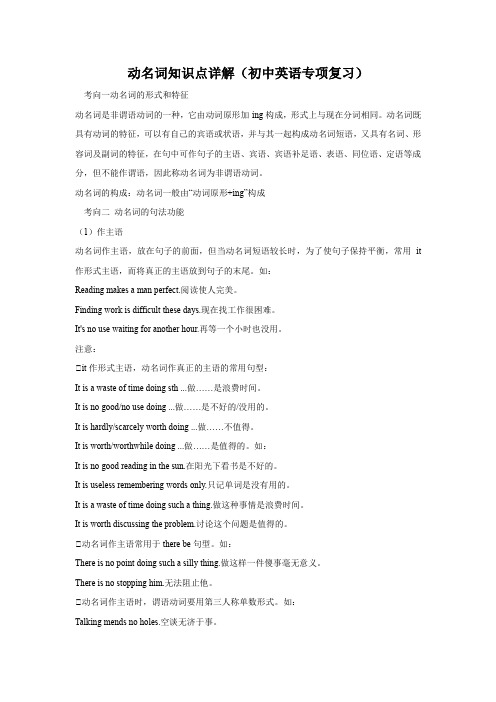
动名词知识点详解(初中英语专项复习)考向一动名词的形式和特征动名词是非谓语动词的一种,它由动词原形加-ing构成,形式上与现在分词相同。
动名词既具有动词的特征,可以有自己的宾语或状语,并与其一起构成动名词短语,又具有名词、形容词及副词的特征,在句中可作句子的主语、宾语、宾语补足语、表语、同位语、定语等成分,但不能作谓语,因此称动名词为非谓语动词。
动名词的构成:动名词一般由“动词原形+ing”构成考向二动名词的句法功能(1)作主语动名词作主语,放在句子的前面,但当动名词短语较长时,为了使句子保持平衡,常用it 作形式主语,而将真正的主语放到句子的末尾。
如:Reading makes a man perfect.阅读使人完美。
Finding work is difficult these days.现在找工作很困难。
It's no use waiting for another hour.再等一个小时也没用。
注意:①it作形式主语,动名词作真正的主语的常用句型:It is a waste of time doing sth ...做……是浪费时间。
It is no good/no use doing ...做……是不好的/没用的。
It is hardly/scarcely worth doing ...做……不值得。
It is worth/worthwhile doing ...做……是值得的。
如:It is no good reading in the sun.在阳光下看书是不好的。
It is useless remembering words only.只记单词是没有用的。
It is a waste of time doing such a thing.做这种事情是浪费时间。
It is worth discussing the problem.讨论这个问题是值得的。
①动名词作主语常用于there be句型。
英语语法动名词用法归纳总结
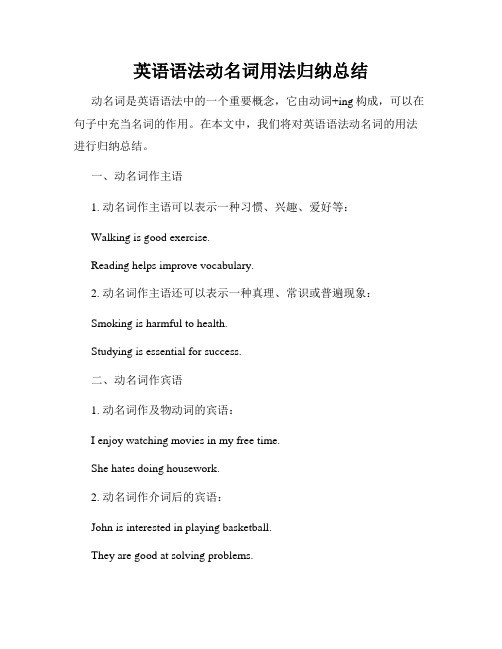
英语语法动名词用法归纳总结动名词是英语语法中的一个重要概念,它由动词+ing构成,可以在句子中充当名词的作用。
在本文中,我们将对英语语法动名词的用法进行归纳总结。
一、动名词作主语1. 动名词作主语可以表示一种习惯、兴趣、爱好等:Walking is good exercise.Reading helps improve vocabulary.2. 动名词作主语还可以表示一种真理、常识或普遍现象:Smoking is harmful to health.Studying is essential for success.二、动名词作宾语1. 动名词作及物动词的宾语:I enjoy watching movies in my free time.She hates doing housework.2. 动名词作介词后的宾语:John is interested in playing basketball.They are good at solving problems.三、动名词作补语1. 动名词作某些动词的补语,表示动作的主体:He kept on talking about his vacation.She felt like dancing all night.2. 动名词作形容词的补语,表示状态或特征:I am tired of studying all day.She is afraid of speaking in public.四、动名词作定语动名词可以作为名词的定语,修饰后面的名词:I bought a running shoe.She is a swimming champion.五、动名词作宾语补足语某些动词后接动名词作宾语补足语,表示动作的完整:I heard him singing in the shower.They saw the girl dancing on the street.六、动名词与不定式的区别1. 动名词表示具体的、正在进行的动作,而不定式表示抽象的、一般性的动作:I enjoy swimming in the ocean. (具体的动作)I enjoy to swim. (不一定正在游泳,只是一般喜欢)2. 多数动词后接动名词作宾语,而很少接不定式作宾语。
初中英语2024届中考语法复习动名词的用法知识讲解

中考英语语法复习动名词的用法知识讲解一、动名词作主语Reading French books is easier than speaking it.Walking is my sole exercise.Talking mends no holes.(谚)空谈无济于事。
Seeing is believing.眼见为实。
注:1)动名词作主语时用it作形式主语,把动名词放到句子后面。
常见句型:①It'+adj(useless,hopeless,nice, good,interesting, expensive,worthwhile) + doing sth.②It's+adj(no use, no good ,fun, a great pleasure, a wonder, a waste of time) +doing sth.【例】It is useless speaking.光说没用。
It’s hopeless arguing about it.争辩这事没有用。
It is nice seeing you again.It is good playing chess after supper.It is expensive running this car.开这种小车是浪费。
Is it worthwhile quarreling with her ?It was a waste of time reading that book.看那本书是浪费时间。
2)“There is +no”后可以用动名词作主语,表示“没法…”:There was no knowing what he could do .没法知道他能做什么。
二、动名词作表语Her job is washing and cooking. My hobby is collecting stamps.Seeing is believing. (谚)眼见为实。
英语中的动名词
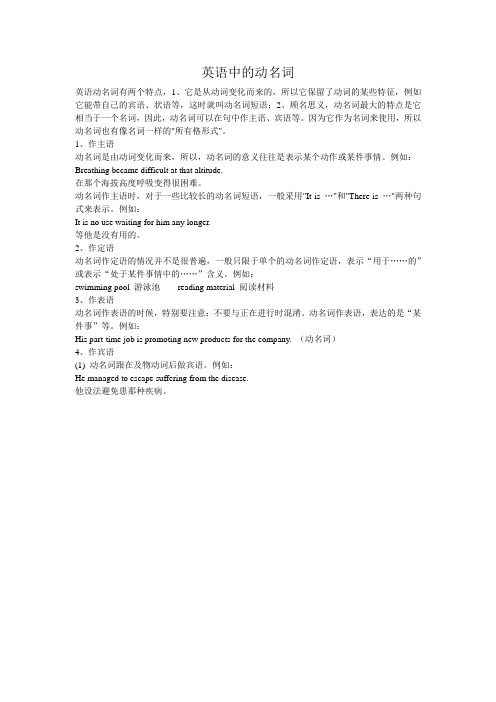
英语中的动名词英语动名词有两个特点,1、它是从动词变化而来的,所以它保留了动词的某些特征,例如它能带自己的宾语、状语等,这时就叫动名词短语;2、顾名思义,动名词最大的特点是它相当于一个名词,因此,动名词可以在句中作主语、宾语等。
因为它作为名词来使用,所以动名词也有像名词一样的"所有格形式"。
1、作主语动名词是由动词变化而来,所以,动名词的意义往往是表示某个动作或某件事情。
例如:Breathing became difficult at that altitude.在那个海拔高度呼吸变得很困难。
动名词作主语时,对于一些比较长的动名词短语,一般采用"It is …"和"There is …"两种句式来表示。
例如:It is no use waiting for him any longer.等他是没有用的。
2、作定语动名词作定语的情况并不是很普遍,一般只限于单个的动名词作定语,表示“用于……的”或表示“处于某件事情中的……”含义。
例如:swimming pool 游泳池reading material 阅读材料3、作表语动名词作表语的时候,特别要注意:不要与正在进行时混淆。
动名词作表语,表达的是“某件事”等。
例如:His part-time job is promoting new products for the company. (动名词)4、作宾语(1) 动名词跟在及物动词后做宾语。
例如:He managed to escape suffering from the disease.他设法避免患那种疾病。
动名词的常见形式
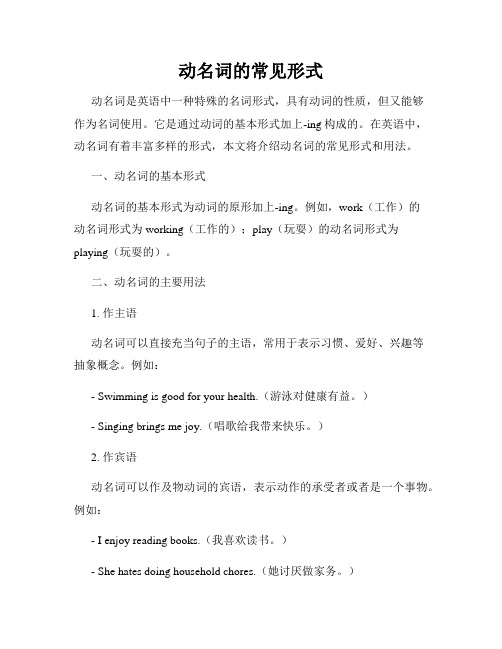
动名词的常见形式动名词是英语中一种特殊的名词形式,具有动词的性质,但又能够作为名词使用。
它是通过动词的基本形式加上-ing构成的。
在英语中,动名词有着丰富多样的形式,本文将介绍动名词的常见形式和用法。
一、动名词的基本形式动名词的基本形式为动词的原形加上-ing。
例如,work(工作)的动名词形式为working(工作的);play(玩耍)的动名词形式为playing(玩耍的)。
二、动名词的主要用法1. 作主语动名词可以直接充当句子的主语,常用于表示习惯、爱好、兴趣等抽象概念。
例如:- Swimming is good for your health.(游泳对健康有益。
)- Singing brings me joy.(唱歌给我带来快乐。
)2. 作宾语动名词可以作及物动词的宾语,表示动作的承受者或者是一个事物。
例如:- I enjoy reading books.(我喜欢读书。
)- She hates doing household chores.(她讨厌做家务。
)3. 在介词后面动名词可以跟在介词后面,表示动作的目的、原因、方式等。
例如:- They are interested in learning foreign languages.(他们对学习外语感兴趣。
)- He succeeded by working hard.(他通过努力工作而获得了成功。
)4. 用于某些固定结构动名词也常常与特定的动词或者形容词搭配,形成一些固定的词组和表达方式。
例如:- keep + 动名词:继续做某事- He keeps talking about his new job.(他一直在谈论他的新工作。
)- can't help + 动名词:忍不住做某事- I can't help laughing at his joke.(听到他的笑话,我忍不住笑了。
)- be + 形容词 + 动名词:被……做得- She is tired of studying all day.(她整天学习让她累了。
英语中的动名词解释
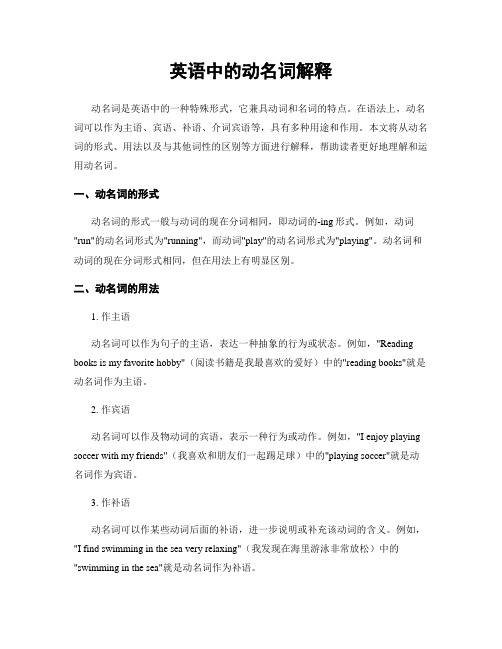
英语中的动名词解释动名词是英语中的一种特殊形式,它兼具动词和名词的特点。
在语法上,动名词可以作为主语、宾语、补语、介词宾语等,具有多种用途和作用。
本文将从动名词的形式、用法以及与其他词性的区别等方面进行解释,帮助读者更好地理解和运用动名词。
一、动名词的形式动名词的形式一般与动词的现在分词相同,即动词的-ing形式。
例如,动词"run"的动名词形式为"running",而动词"play"的动名词形式为"playing"。
动名词和动词的现在分词形式相同,但在用法上有明显区别。
二、动名词的用法1. 作主语动名词可以作为句子的主语,表达一种抽象的行为或状态。
例如,"Reading books is my favorite hobby"(阅读书籍是我最喜欢的爱好)中的"reading books"就是动名词作为主语。
2. 作宾语动名词可以作及物动词的宾语,表示一种行为或动作。
例如,"I enjoy playing soccer with my friends"(我喜欢和朋友们一起踢足球)中的"playing soccer"就是动名词作为宾语。
3. 作补语动名词可以作某些动词后面的补语,进一步说明或补充该动词的含义。
例如,"I find swimming in the sea very relaxing"(我发现在海里游泳非常放松)中的"swimming in the sea"就是动名词作为补语。
4. 作介词宾语有些介词后面需要使用动名词作为宾语。
例如,"I am interested in learning new languages"(我对学习新语言感兴趣)中的"learning new languages"就是动名词作为介词"in"的宾语。
英语语法基础知识——动名词

动名词动名词是动词的另外一种非限定形式,通常由动词+-ing形式构成。
它具备动词的某些特点,有时态和语态上的变化,可以有自己的宾语或状语;也具备名词的特点,可以带冠词,被形容词、代词及名词所有格所修饰,在句中起名词的作用,单独或引起短语作主语,表语,宾语,或介词的宾语等。
一、动名词的形式和意义1. 动名词的一般式通常表示一般性动作(即不是明确地在过去、现在或将来发生的动作),或是表示与谓语所表示的动作同时发生的动作。
e.g. I) They are interested in climbing mountains.II) He took a great delight in helping others.2. 如果动名词所代表的动作在谓语所表示的动作之前发生,则通常用动名词的完成形式。
e.g. I) He denied having peeked at his neighbor’s t est paper. 他否认偷看了他同桌的考卷。
II) He was praised for having made such a contribution to the country.【注】在某些动词后或成语中,也常用动名词的一般形式表示在谓语动词所表示的动作之前所发生的动作。
e.g. I) I don’t remember ever seeing him anywhere.II) Thank you for giving us so much help.3. 当一个动名词逻辑上的主语所表示的是这动作的对象时,这动名词一般要用被动形式。
如果动名词所表示的动作在谓语表示的动作之前发生,有时还需用动名词的完成被动式。
e.g. I) He could not bear being made fun of like that. 人家这样开他的玩笑他受不了。
II) You can’t eat anything before being operated on.III) I don’t remember having ever been given a chance to try this metho d. 我不记得谁给我试验这方法的机会。
英语动名词知识点

英语动名词知识点
英语动名词(Gerunds)是指以-ing 结尾的名词形式,它的功能类似于名词,在句子中可以担任主语、宾语、表语等成分。
以下是英语动名词的一些知识点:
1. 动名词的构成:动名词通常由动词的-ing 形式构成,例如:swimming, playing, studying 等。
2. 动名词的用法:动名词可以作为主语、宾语、表语、定语和状语等。
例如:Swimming is good exercise.(游泳是很好的运动。
)I enjoy reading books.(我喜欢读书。
)
3. 动名词与不定式的区别:动名词和不定式都可以作为动词的名词形式,但它们在用法上有所不同。
动名词通常表示一种持续性的行为或习惯,而不定式则更倾向于表示一种意图或目的。
例如:I like swimming.(我喜欢游泳。
)I want to swim.(我想游泳。
)
4. 动名词的时态和语态变化:动名词本身没有时态和语态的变化,但它可以和助动词一起构成各种时态和语态。
例如:I was swimming.(我正在游泳。
)The book needs proofreading.(这本书需要校对。
)
5. 动名词的常用搭配:动名词可以与不同的介词、动词、形容词等组合使用,构成不同的搭配,例如:interested in, good at, tired of 等。
以上是英语动名词的一些基本知识点,希望对您有所帮助。
如果您还有其他问题,欢迎继续向我提问。
英语 动名词 专题讲解

动名词1.作主语如果动名词较长,可用作形式主语,而将真正的主语动名词置于句末。
如:Seeing is believing. (眼见为实。
)It is no use arguing with him. (和他争吵没有用。
)It made her very happy staying with her best friends. (和她最好的朋友们待在一起使她感到非常快乐。
)注意:动名词和不定式都可以作主语,动名词作主语表示一般或抽象的多次行为,不定式作主语往往表示具体的或一次性的动作。
如:Playing with fire is dangerous. 玩火很危险。
(泛指玩火)To play with fire will be dangerous. 玩火很危险。
(指一次具体动作)但在it is no use/good, not any use/good, useless 等后常用动名词而极少用不定式。
如:It is no good smoking. (吸烟没有好处。
)2.作宾语(1)admit, appreciate, avoid, consider, delay, dislike, enjoy, escape, excuse, face, feel, like, finish, forgive, imagine, include, keep, mention, mind, miss, practise, resist, risk, suggest 等动词后用动名词作宾语,不用不定式。
如:Did he admit breaking the vase?(他承认花瓶是他打破的吗?)I suggest solving this problem in a different way. (我建议用不同的文法来解决这个问题。
)You must avoid taking sweet foods, e.g. cake, chocolate, and ice-cream.(你必须避免吃甜食,诸如蛋糕、巧克力和冰淇淋。
英语中动名词是什么

英语中动名词是什么动词有四种变化形态,分别是:不定式(to do)、动名词(V-ing)、现在分词(V-ing)和过去分词(V-ed)。
再次强调以下至关重要的概念:不定式是助动词的变化,带有不确定的语气;动名词是动词的名词化,可以用在主语及宾语等位置;而分词则是形容词化,可以当形容词用。
动名词是具有名词性质的动词形式,是一种非谓语动词,这种形式兼有动词性质和名词性质,在句子中可以做主语、宾语、表语、定语等成分,几乎名词能做的成分动名词都能作,所以动名词可以说是更倾向于名词,因此叫动名词。
(归根结底动名词的词性是名词。
)一、动名词作主语。
1、直接位于句首,如:Swimming is a good sport in summer.在夏天,游泳是一项好的消遣。
2、用it 作形式主语,把动名词(真实主语)置于句尾作后置主语。
,如:It is no use telling him not to worry.告诉他不要担心是没有用的。
(这个句型中真正主语只能是v-ing形式)注意:important,essential,necessary 等形容词不能用于上述结构。
3. 用于“There be”结构中,如:There is no saying when he'll come.很难说他何时回来。
(There is + no + doing something 是英语中的固定搭配,表示“说不上du;很难说”。
)4. 动名词的复合结构作主语:当动名词有自己的逻辑主语时,常可以在前面加上一个名词或代词的所有格,构成动名词的复合结构, 动名词疑问句通常使用这种结构做主语Their coming to help was a great encouragement to us.他们来支援我们是很大的鼓舞。
Does your saying that mean anything to him?你的话对他有什么意义吗?二、动名词作宾语1. 作动词的宾语某些动词后出现非限定性动词时只能用动名词作宾语,不能用不定式。
英语中动名词的结构知识讲解

英语中动名词的结构知识讲解动名词(-ing)作为三种非谓语动词之一,动名词(-ing)的应用范围同不定式一样广泛,可以用于主语、表语、宾语、定语、状语。
动名词的结构:动名词(-ing)都是在动词原形后加ing构成的,少数词尾特殊的动词加ing时有点特别的变化:1)词尾:一般情况加法:直接加ing例词:work→working(工作)shout→shouting(呼喊)2)词尾:以不发音的e结尾加法:先去e,再加ing例词:bake→baking(烤)take→taking(拿)3)词尾:以一个辅音字母结尾的重读闭音节加法:先双写最后一个辅音字母,再加ing例词:beg→begging(乞讨)forget→forgetting(忘记)以y结尾的动词不要改y为i,这与名词加s和动词加es的方法不同。
√study→studying×study→studiing个别例外的变形:√lie(说谎)→lying×lie→lieing动名词(-ing)与不定式一样,可以带宾语、宾补、状语和逻辑主语,组成下列常用结构:1.基本型:原形动词+ing,举例:studying2.带宾语:原形动词+ing+宾语,举例:studyingEnglish3.带宾补:原形动词+ing+宾语+宾补,举例:askingsb. to do4.带状语:原形动词+ing+状语,举例:working hard5.带逻辑主语:代词+原形动词+ing,举例:him/his smiling名词所有格+原形动词+ing,举例:Bill’s smiling6.否定式:not+原形动词+ing,举例:not smiling动名词的时态和语态形式:本文作者:丹丹英语(公众号:英语语法学习)。
动名词的用法讲解

动名词的用法讲解
动名词是指以-ing结尾的词,它既有动词的意义,又有名词的功能。
动名词通常用来表示某种行动或状态的持续性、重复性或延续性。
常见的用法有以下几种:
1. 作主语/宾语:Walking is good for your health.(散步对
健康有益)
2. 作介词宾语:I’m interested in learning English.(我对学习
英语很感兴趣)
3. 作定语:The running water sounds relaxing.(流水声很令人放松)
4. 作表语:Her favorite hobby is singing.(她最喜欢的爱好是唱歌)
5. 作补语:I enjoy swimming in the sea.(我喜欢在海里游泳)
6. 作复合宾语:She kept practicing speaking English.(她一直
保持练习说英语)
需要注意的是,动名词还可以与情态动词、助动词、不定式构成
复合结构,例如:He should stop smoking(他应该戒烟)。
此外,
有些动词后既可以跟动名词,也可以跟不定式,但意义有所不同,例如:remember doing sth.(记得做过某事)和 remember to do sth.(记得去做某事)。
总之,动名词在英语中是一种非常常见的词类,掌握它的用法能
够大大提高语言表达能力。
英语动名词相关知识点详解
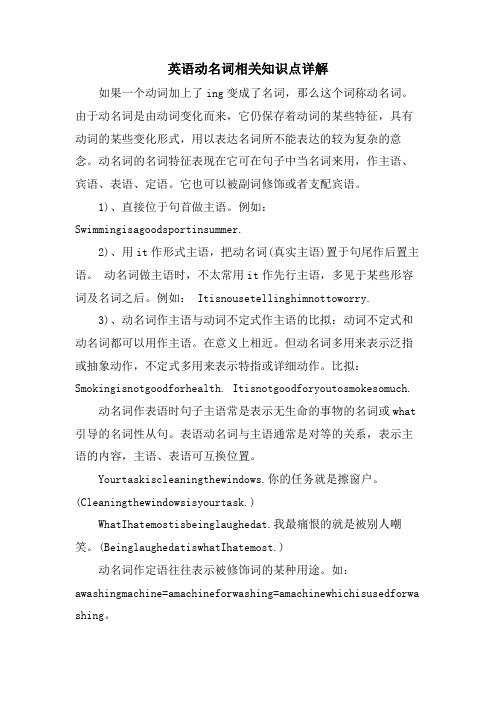
英语动名词相关知识点详解如果一个动词加上了ing变成了名词,那么这个词称动名词。
由于动名词是由动词变化而来,它仍保存着动词的某些特征,具有动词的某些变化形式,用以表达名词所不能表达的较为复杂的意念。
动名词的名词特征表现在它可在句子中当名词来用,作主语、宾语、表语、定语。
它也可以被副词修饰或者支配宾语。
1)、直接位于句首做主语。
例如:Swimmingisagoodsportinsummer.2)、用it作形式主语,把动名词(真实主语)置于句尾作后置主语。
动名词做主语时,不太常用it作先行主语,多见于某些形容词及名词之后。
例如: Itisnousetellinghimnottoworry.3)、动名词作主语与动词不定式作主语的比拟:动词不定式和动名词都可以用作主语。
在意义上相近。
但动名词多用来表示泛指或抽象动作,不定式多用来表示特指或详细动作。
比拟:Smokingisnotgoodforhealth. Itisnotgoodforyoutosmokesomuch.动名词作表语时句子主语常是表示无生命的事物的名词或what 引导的名词性从句。
表语动名词与主语通常是对等的关系,表示主语的内容,主语、表语可互换位置。
Yourtaskiscleaningthewindows.你的任务就是擦窗户。
(Cleaningthewindowsisyourtask.)WhatIhatemostisbeinglaughedat.我最痛恨的就是被别人嘲笑。
(BeinglaughedatiswhatIhatemost.)动名词作定语往往表示被修饰词的某种用途。
如:awashingmachine=amachineforwashing=amachinewhichisusedforwa shing。
例:Wearethinkingofmakinganewplanforthenextterm.我们正考虑为下学期制定新的方案。
stopdoingsth,停顿正在做的事情stoptodosth停下来做另外一件事;remember,forget,regret的不定时构造指后于谓语动词的动作,动词的ing形式那么先于谓语动词的动作remembertodo/doing:①Irememberedtoposttheletters.(指未来/过去未来将要做的动作)②Irememb eredposting/havingpostedtheletters.(我记得做过这个动作)tryto(努力)与try+–ing(试验):①Itriednottogothere.(我设法不去那里)②Itrieddoingitagain.(我试着又干了一次);goontodosth继续做某事(不是同一件事),goondoingsth继续做某事(同一件事);。
英语中什么是动名词
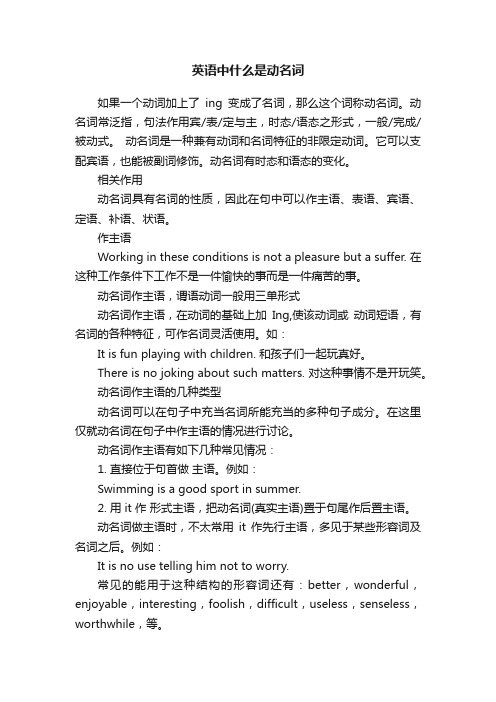
英语中什么是动名词如果一个动词加上了ing变成了名词,那么这个词称动名词。
动名词常泛指,句法作用宾/表/定与主,时态/语态之形式,一般/完成/被动式。
动名词是一种兼有动词和名词特征的非限定动词。
它可以支配宾语,也能被副词修饰。
动名词有时态和语态的变化。
相关作用动名词具有名词的性质,因此在句中可以作主语、表语、宾语、定语、补语、状语。
作主语Working in these conditions is not a pleasure but a suffer. 在这种工作条件下工作不是一件愉快的事而是一件痛苦的事。
动名词作主语,谓语动词一般用三单形式动名词作主语,在动词的基础上加Ing,使该动词或动词短语,有名词的各种特征,可作名词灵活使用。
如:It is fun playing with children. 和孩子们一起玩真好。
There is no joking about such matters. 对这种事情不是开玩笑。
动名词作主语的几种类型动名词可以在句子中充当名词所能充当的多种句子成分。
在这里仅就动名词在句子中作主语的情况进行讨论。
动名词作主语有如下几种常见情况:1. 直接位于句首做主语。
例如:Swimming is a good sport in summer.2. 用 it 作形式主语,把动名词(真实主语)置于句尾作后置主语。
动名词做主语时,不太常用it 作先行主语,多见于某些形容词及名词之后。
例如:It is no use telling him not to worry.常见的能用于这种结构的形容词还有:better,wonderful,enjoyable,interesting,foolish,difficult,useless,senseless,worthwhile,等。
注意:important,essential,necessary 等形容词不能用于上述结构。
3. 用于“There be”结构中。
英语语法:动名词的详细分析讲解

英语语法:动名词的详细分析讲解1. 动名词概说动名词既具有动词的性质,又具有名词的性质,因此叫动名词。
①动名词的动词性质表现在,它可以和宾语或状语组成动名词短语如:My job is arranging the agenda for my boss.我的工作是为老板安排日程。
I finished the project in a month by working overtime.我靠加班在一个月内做完了这个项目。
②动名词的名词性质表现在,它可以在句巾用作主语、宾语等如:Studying abroad can be a good experience.留学是一种很好的经历。
(作主语)I regret telling her the truth.我后悔告诉她事实真相了。
(作宾语)2. 动名词的形式和特征动名词由“动词原形do+ - ing”构成。
动名词有以下时态与语态的变化:①动名词的一般式1)一般式所表示的动作和谓语动词的动作同时发生,表示经常性、习惯性的动作(或状态),也可能在谓语动词表示的动作之后发生。
I enjoy skiing in nature.我享受在大自然中滑雪。
(enjoy与skiing同时发生)He insisted on going with us.他坚持跟我们一起去。
(going发生在insisted on之后)2)有的动名词所表示的动作发生在谓语动词表示的动作之前,如:We don't remember reading the article before.我们不记得以前看过这篇文章了。
(reading发生在remember之前)They will never forget running into the super model in the mall.他们永远不会忘记在商场里偶遇那位超模。
(running into发生在forget之前)②动名词的完成式动名词的完成式表示的动作发生在谓语动词表示的动作之前。
动名词的用法讲解

解析: remember telling me意为 “记得曾经告诉过我”。
(2)在有些句子中,介词常可省去。
ห้องสมุดไป่ตู้
I have no difficulty (in) communicating with foreigners. 我在和外国人交谈方面没有什么困难。 He used to spend a lot of time (in) playing games. 过去他常花很多时间玩游戏。 What can prevent us (from) going there? 有什么能阻止我们去那呢?
forget regret remember
to do 将要发生的动作
doing 已经发生的动作
go on doing
go on to do stop doing
stop to do mean doing
继续做同一件事情 继续做另一件事情 停止做某事 停下来做另一件事 意味着做某事 打算做某事
mean to do
(4) want(需要), need(需要),
deserve(值得), require(需要)等词
后,我们用动名词的主动形式表达被动
意思。后跟动名词的主动式与不定式的 被动式作宾语,意义没有区别。如: The window needs/requires/wants cleaning/to be cleaned.
e.g.
①She sat there without speaking. ②I look forward to seeing him again.
③Are you used to living there alone?
⑤He was busy(in) preparing his lessons.
动名词 举例

动名词举例动名词是英语语法中的一个重要概念,在英语中起着多种语法和语义的作用。
本文将对动名词进行详细的阐述,包括其定义、用法、特点以及举例等方面,旨在帮助读者更好地理解和掌握动名词的用法。
一、动名词的定义与用法动名词是动词变形的一种形式,在句子中可以作名词使用。
动名词的构成方式为动词+ing(如:walking、talking),其主要有以下几种用法:1.作主语:动名词作主语时,通常指一种习惯性或经常性的行为,如:“Running is good for your health.”(跑步对健康有益)。
2.作宾语:动名词作宾语时,表示动作或者状态被实施,如:“I enjoy swimming in the summer.”(夏天我喜欢游泳)。
3.作介词的宾语:动名词作介词的宾语时,常常用于介词的后面,如:“He is interested in playing basketball.”(他对打篮球很感兴趣)。
4.作定语:动名词作定语时,多与名词连用,起修饰限定的作用,如:“A shopping mall is a good place to relax.”(购物中心是一个休闲的好地方)。
二、动名词的特点动名词具有以下几个特点:1.可数与不可数:动名词可以数和不可数,具体是由与其搭配的冠词,量词或表量的形容词来决定。
2.与动词之间的区别:动名词和动词在形式上是相似的,但在语义和用法上有所区别,读者应该注意区分。
3.逻辑主语的形式:在动名词短语中,逻辑主语的形式决定了动名词的格位。
三、动名词的具体用法举例接下来,我们将从各个方面对动名词的用法进行举例阐述,旨在帮助读者更好地理解和掌握动名词的用法。
1.习惯性行为:Doing exercise is good for your health.(锻炼对健康有益)。
2.动作或状态被实施:I love cooking.(我喜欢烹饪)。
3.与介词搭配:She is fond of reading.(她喜欢阅读)。
英语语法动名词专题讲解
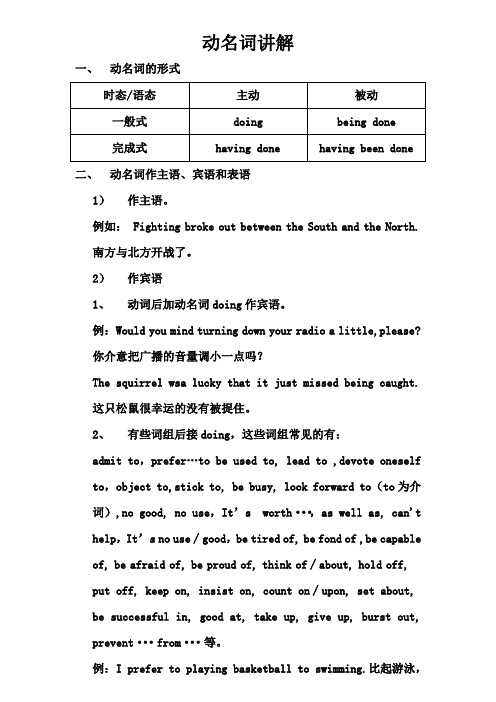
动名词讲解一、动名词的形式时态/语态主动被动一般式doing being done完成式having done having been done 二、动名词作主语、宾语和表语1)作主语。
例如: Fighting broke out between the South and the North.南方与北方开战了。
2)作宾语1、动词后加动名词doing作宾语。
例:Would you mind turning down your radio a little,please?你介意把广播的音量调小一点吗?The squirrel wsa lucky that it just missed being caught.这只松鼠很幸运的没有被捉住。
2、有些词组后接doing,这些词组常见的有:admit to,prefer…to be used to, lead to ,devote oneself to,object to,stick to, be busy, look forward to(to为介词),no good, no use,It’s worth···,as well as, can't help,It’s no use∕good,be tired of, be fond of ,be capable of, be afraid of, be proud of, think of∕about, hold off, put off, keep on, insist on, count on∕upon, set about, be successful in, good at, take up, give up, burst out, prevent···from···等。
例:I prefer to playing basketball to swimming.比起游泳,我更喜欢打篮球。
- 1、下载文档前请自行甄别文档内容的完整性,平台不提供额外的编辑、内容补充、找答案等附加服务。
- 2、"仅部分预览"的文档,不可在线预览部分如存在完整性等问题,可反馈申请退款(可完整预览的文档不适用该条件!)。
- 3、如文档侵犯您的权益,请联系客服反馈,我们会尽快为您处理(人工客服工作时间:9:00-18:30)。
不大。但在下列几种情况中不能互换: a. 当表语是动名词时,主语也要用 动名词;当表语是不定式时,主语也 要用不定式 (对等性)如:
2.动名词(短语)作表语,如: Their job is building houses. His job is raising pigs. 注①:动名词作表语与不定式作表语的区别: 1. 动名词作表语时表示比较抽象的一般行为、习惯; 2.不定式作表语时表示具体的某一次动作,特别是将来的动作,试
To do that sort of thing is foolish。
主语
动 词 不 定 式
I want to see you this evening.
All you have to do is to finish it quickly.
宾语 表语
We found a house to live in.
动 名 词
动名词
非 谓 语 动 词
现在分词 分 词 过去分词
不定式
不定式: 具有n. adj. adv. 特征,
在句中担任除谓语外任何成分; 动名词: 具有n. 特征,在句中可 作主语、宾语、定语、表语; 分词: 具有adj. adv. 特征,在句中 可作主语、表语、宾补、状语;
①有语态和部分时态的变化; ②可以有自己的宾语和状语, 同其宾语和状语一起构成短 语; ③还可有逻辑主语;
My job is teaching. = Teaching is my job. Her full-time job is laying eggs. =Laying eggs is her full-time job.
2.表语
Your task is cleaning the windows.
Their coming to help was a great encouragement to us.
I don’t like Andy’s smoking in the office.
动名词的复合结构作主语 当动名词有自己的逻辑主语时,常可以在前面 加上一个名词或代词的所有格,构成动名词的复 合结构(——这时,名词或代词的所有格做动名词 的逻辑主语)。
另一类是既可以用动名词,又可以用不定
式作宾语的动词,其中有:
begin,
cannot bear, continue, forget, hate, intend, like, love, plan, prefer, propose, regret, remember, start, try, want, need等。
It
is no use crying over spilt milk. It is no point arguing with him about this. 动名词作主语,有时先用it作形式主语,把 动名词置于句末。这种用法在习惯句型中常 用。
It’s no use /no good/no point doing … It’s a waste of time doing … It’s worth doing …
在“There be”结构中,只能用动名词做主语, 而不能用不定式。
3.宾语
一类是只能用动名词作宾语的动词,其中有: avoid, admit, consider, delay, advise, enjoy, escape, excuse, finish, can’t help, imagine, keep (on), mind, miss, practise, stop, go on, suggest 等,
不定式作主语往往特指具体的某此动作,尤其是将来的动作。
e.g) Smoking is harmful to people’s health. (泛指) To solve the problem is out of the question. (特指)
动名词作主语与不定式作主语的区别:
Sweeping the floor every day is the cleaner’s job. (抽象,泛指) To sweep the floor today is my job.(具体)
比较:
My favourite sport is swimming. The first thing for us to do is to improve our pronunciation.
There is no joking about such matters. There is no saying when he'll come.
二、动名词的时态和语态
时态:
如果动名词的动作没有明确的表示出时间是与谓语 动词同时还是在之前发生,用动名词的一般式。 We are interested in listening to music. 如果动名词的动作发生在谓语动词的动作之前,用 动名词完成式。 She apologized to me for having kept me waiting for such a long time. 注意: after / before / on 后面的动名词不用完成 时态。 e.g) On hearing the news that we won the game, we were all wild with joy. He closed all the windows before leaving.
直接作主语
Teaching is my full-time job. Writing an English composition is not easy. 有时为了避免句子主语冗长,通常用it代替 v-ing作主语
It’s useless taking this kind of medicine.
Cleaning the windows is your task.
What I hate most is being laughed at.
Being laughed at is what I hate most.
•表语动名词与主语通常是对等的关系,表示 主语的内容,主语、表语可互换位置。
To see is to believe. Seeing is believing.
动名词—名词;习惯性动作 不定式—将来;一次性动作 现在分词: 动作正在进行;表主动 过去分词: 动作已经完成;表被动
﹡一般式:
不定式表示的动作与谓语动词表 示的动作同时发生,或者在谓语 动词表示的动作之后发生。
I’m glad to see you. (同时发生) They invited us to come to a party.(不定式动作后发生)
动名词作主语的形式主语句型
1.It is no use /good doing…. 2.It is not any use/good doing…. 3.It is worthwhile doing…. 4.It is hardly worth doing…. 5.There is no doing…. 6.It’s a waste of time doing…. E.g. It’s no good telling her all the truth. It’s no use crying over the spilt milk. There is no talking what will happen. It’s a waste of time arguing about it. It is worthwhile trying this experiment.
She came here to study English.
ห้องสมุดไป่ตู้
定语
状语
I warned the patient not to eat cold water after the operation. 宾补
兼具动词和名词的两种特征:动词有时态语态,有 宾语;名词有所有格,可以做主宾语,表语等等。 Helping him gave me a sense of pride. His house was damaged in the fire. My smoking caused this terrible fire. My parents dislike me/my smoking.
、功能及用法
1.动名词(短语)做主语,谓语用单数.如: Writing the book has taken up all his spare time. Judging people by his appearance is silly. 注:动名词作主语与不定式作主语的区别:
1) 动名词作主语往往泛指比较抽象的一般行为,如爱好、习惯等;
一.结构 : to do (否定) not/never to do 二. 时态与语态 不定式 主动语态
被动语态
to be done
----------
一般式 进行式
完成式
to do to be doing
完成进行式
to have been to have done done to have been ---------doing
动名词能在句中充当什么成分?
性质 主语 表语 宾语 宾补 定语 状语 动名 n. pron. 词
五、动名词的复合结构
动名词的复合结构就是前面带有代词或名词的动名词结构。 She won’t hear of us leaving the village. Do you object to Li Ping’s joining the physics group? 注①:逻辑主语是有生命的名词:作主语时,必须用名词或代词所 有格;作宾语时,也可用名词的普通格或人称代词宾格,如: The student’s knowing English well helped him in learning French. I don’t mind my / me / Jane buying another one. 注②:如果动名词的逻辑主语是表示无生命的东西的名词,或不定 代词,就只能用普通格,不能用所有格,如: Is there any hope of your team winning the match? The boy was alarmed by someone knocking at the door.
